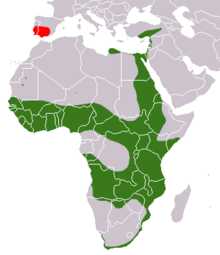Egyptian mongoose
| Egyptian Mongoose | |
|---|---|

| |
| Scientific classification | |
| Kingdom: | |
| Phylum: | |
| Class: | |
| Order: | |
| Family: | |
| Subfamily: | |
| Genus: | |
| Species: | H. ichneumon
|
| Binomial name | |
| Herpestes ichneumon | |

| |
| Egyptian Mongoose range (green - native, red - introduced) | |
The Egyptian Mongoose (Herpestes ichneumon), also known as the Ichneumon, is a species of mongoose. It may be a reservoir host for Visceral leishmaniasis in Sudan.[2]
Range and habitat
This mongoose can be found in Egypt, Spain, Portugal, Israel, and most of sub-Saharan Africa, except for central Democratic Republic of the Congo, western South Africa, and Namibia. It has been introduced to Madagascar and Italy.[3]
It prefers to live in forests, savanna, or scrub, but never far from water.[4]
Description

The largest of all African mongooses,[4] the Egyptian Mongoose has a body 48–60 cm long, and a 33–54 cm tail. It weighs 1.7–4 kg.[5]
The Egyptian Mongoose has a slender body, with a pointed snout and small ears. It has 35–40 teeth, with highly developed carnassials, used for shearing meat. Its long, coarse fur ranges in colour from grey to reddish brown and is ticked with brown or yellow flecks. Their tails have black tips. The hind feet and a small area around the eyes are furless.
Behaviour
Males and females become sexually mature at two years of age. Mating occurs in July or August, and after a gestation period of 11 weeks, the female gives birth to 2–4 young. Egyptian Mongooses are blind and hairless when born, but open their eyes after about a week.[4]
The Egyptian Mongoose is diurnal and lives in small groups of 1–7 animals, usually consisting of a male, several females, and their young. Male offspring usually leave the group before they are a year old; females stay longer, and may not leave at all.[5]
Most wild mongooses live for 12 years. The longest lived captive mongoose was over 20 years old.[3]
Its diet consists mainly of meat, including rodents, fish, birds, reptiles, amphibians, and insects. Fruit and eggs are also popular food items; to crack it open, the latter is characteristically thrown between the legs against a rock or wall. Like other mongooses, the Egyptian Mongoose will attack and eat venomous snakes. They have at least two different types of resistance to snake venom. They are up to ten times as resistant to toxins which attack the nervous system.[6] And they are also resistant to toxins that attack the circulatory system. [7]
In some rural areas of Egypt, such as upper Egypt, it is bred as a household pet.
Conservation
The Egyptian Mongoose is extremely numerous. While its numbers threaten other species, it is not at risk of extinction.[3]
Ephemera
John Greenleaf Whittier, American poet, wrote a poem as an elegy for an ichneumon, which had been brought to Haverhill Academy in Haverhill, New Hampshire, in 1830. The long lost poem was published in the November 20, 1902 issue of "The Independent" Magazine.
In Christopher Smart's poem, Jubilate Agno, the poet's Cat Jeoffry was praised in line 63: "For he killed the Ichneumon-rat very pernicious by land," for a purported attack on an Egyptian Mongoose.
See also
References
- ^ Template:IUCN2008 Database entry includes a brief justification of why this species is of least concern
- ^ "The Egyptian mongoose, Herpestes ichneumon, is a possible reservoir host of visceral leishmaniasis in eastern Sudan". Retrieved 2007-04-17.
- ^ a b c "Animal Diversity Web: Herpestes ichneumon". Retrieved 2007-04-17.
- ^ a b c "Blue Planet Biomes". Retrieved 2007-04-17.
- ^ a b "Lioncrusher's Domain". Retrieved 2007-04-17.
- ^ Ovadia, M. and Kochva. E. (1977) Neutralization of Viperide and Elapidae snake venoms by sera of different animals. Toxicon 15. 541-547.
- ^ Orna Ashera, Monica Lupu-Meirib, Bo S. Jensena, Tamar Papernaa, Sara Fuchsa, Yoram Oronb. 1998. Functional characterization of mongoose nicotinic acetylcholine receptor K-subunit: resistance to K-bungarotoxin and high sensitivity to acetylcholine. FEBS Letters 431: 411 - 414.

